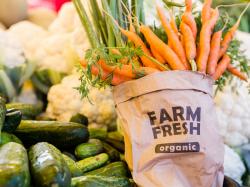Consumers Continuing To Demand Organic Fresh Produce Options
September 1, 2017 | 3 min to read

Salinas, CA — Buoyed by consumers’ desire to know as much about where the produce they buy comes from and how it was grown, organic fresh produce accounted for $1.25 billion dollars in sales at the end of the second quarter 2017, an 8 percent increase in dollars and 10 percent rise in volume from the previous year, according to the Organic Produce Network (OPN).
Partnering with Nielsen, OPN’s review of second quarter organic fresh produce sales at retail stores across the country shows dollar sales of organic fresh vegetables were $608 million while organic fresh fruit sales were $425 million. Collectively, organic fresh fruits and vegetables represented nearly 10 percent of all produce dollars at the end of the second quarter.
Overall, from the previous 12-month period, sales of organic fruit were up 12.3 percent, while sales of organic vegetables rose 5.7 percent.
“Looking at these trends, it is clear that there is a continued interest in organic produce and a movement toward transparency in general,” says Matt Lally, client manager for Nielsen Fresh. “Today’s consumer is interested in eating simpler, cleaner products and this is reflected in the continued growth we are seeing with organic fresh produce.”
The $234 million-dollar organic packaged salad category led the way in terms of sales during the second quarter this year, accounting for 19.5 percent of organic produce sales. The volume rise of 5.6 percent compared to a year ago could be an indication that lower retail prices are helping to boost sales in this convenience-based category.
During the second quarter, the $175 million-dollar berry category accounted for the second highest share of organic sales and had an average retail price of $4.19. Berries, which represented 14.6 percent of organic produce sales in the second quarter, saw a 22.1 percent jump in dollars and 16.6 percent increase in volume compared to a year ago. While berries as a whole have been on a strong upward trend for some time, organic growth continues to be at a faster pace than its conventional counterparts.
The $59 million-dollar banana category, the third largest fruit segment behind berries and apples, experienced a 25 percent increase in volume over 2016, which is impressive considering conventional banana sales have struggled recently. Likewise, pineapples saw a 35 percent jump in volume during the same period.
“Its clear growers and shippers are clearly responding to continued interest in organic fresh produce by increasing production and availability of key commodities," said Matt Seeley, CEO of the Organic Produce Network. “For their part, it appears retailers are working harder as well to ensure that in-demand organic produce items are represented on their shelves.”
Interestingly, 10 organic commodities account for nearly three-quarters of all organic produce dollars. In addition to packaged salads and berries, rounding out the list are herbs, spices and seasonings, apples, beverages, carrots, bananas, lettuce, tomatoes and citrus.
Within the $47.5 million value-added organic produce category, (which includes baby peeled carrots, green beans and vegetable trays and medleys), the segment saw a 2.7 percent increase in dollar sales and a 4.5 percent jump in volume during the second quarter of 2017 compared to last year, with overall retail prices about two percent lower than the same period last year. Consumer preference seems to lean more toward value-added vegetables than it does value-add fruit, which was down close to 6 percent in volume at the end of the second quarter.
More than likely, higher retail prices in this category segment, some 4 percent on average for organic fruit vs. a year ago, curtailed consumer interest. The impact was most dramatic with watermelons which saw a 13 percent rise in average retail price but a 67 percent decline in volume compared to a year ago and honeydew melons which had a 47 percent jump in price and saw a 60% decline in volume during the same period.
“Retailers we spoke with concurred that cost has been one of the biggest hurdles in growing sales of value-added organic fresh produce and fruit in particular. They point out that future growth will be dependent on finding the sweet spot between offering convenience-based organic fresh produce and fair pricing,” Seeley said.
###
About OPN
Founded by agricultural industry veterans Matt Seeley and Tonya Antle, The Organic Produce Network (OPN) was established as a vibrant on-line and live content programming organization connecting the entire organic fresh produce industry.
Designed as the voice and go-to resource for all things related to organic produce, the company's mission is to inform and educate through a strong digital presence with an emphasis on original content, and complimented by engaging live events which bring together various components of the organic food community. For more information about OPN, visit www.organicproducenetwork.com
Source: The Organic Produce Network (OPN)
